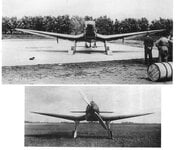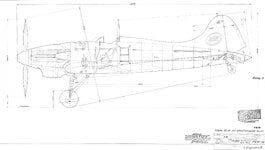don4331
Senior Airman
I think you are optimistic on Bf.113 Performance:
I didn't complete some of the cells as they aren't critical; Hurricane performance is for fixed pitch propeller on 87 octane - what the Luftwaffe encountered during the BoF. As may be seen, both Luftwaffe fighters enjoy a substantial performance advantage.
For the BoB, the Hurricane has been upgraded with CS propeller and 100 octane fuel - performance is very close to Bf.110 (individual aircraft are probably better/worse)
The Bf.109 basically gets 4 mpg whether internal or internal + drop tank. So, to fly 560 miles, it needs 140 Imp gal. For the Bf.113 with annual radiator, assuming the same 66 Imp gal fuselage tank of the Bf.109G-12, you need 74 gal in wings. There is space in the wings for 37 gal/side between main and rear spar but:
 tomo pauk
also specified the same 2 - MG FF and 4 - MF 17 from Bf.110; upgrading from MG 17 to MG FF added 100 lbs from Bf.109E-0 to Bf.109E-3
tomo pauk
also specified the same 2 - MG FF and 4 - MF 17 from Bf.110; upgrading from MG 17 to MG FF added 100 lbs from Bf.109E-0 to Bf.109E-3
The Bf.113 has performance equal to BoF Hurricane and inferior to BoB uprated ones.
If Bf.110 struggled in BoB, the Bf.113 is going to struggle in BoF and going to be in real trouble in BoB. And it's going to be too slow and too short ranged to be a decent night fighter (Ju.88 and He.219 had much greater range and so were better night fighters for average pilot)
| Airplane | Bf.109E-0 | Bf.110C-3 | Hurricane Mk.1 |
| Empty weight | 4,430lbs | ||
| Loaded weight | 5,520lbs | ||
| Wing area | 177ft^2 | ||
| Range | 350 mi | 560 mi | |
| Fuel | 88 Imp gal | 279 Imp gal | 87 Octane |
| Top speed | 348 mph | 334 mph | 314 mph |
| Cruiser | 236 mph | 224 mph | 212 mph |
I didn't complete some of the cells as they aren't critical; Hurricane performance is for fixed pitch propeller on 87 octane - what the Luftwaffe encountered during the BoF. As may be seen, both Luftwaffe fighters enjoy a substantial performance advantage.
For the BoB, the Hurricane has been upgraded with CS propeller and 100 octane fuel - performance is very close to Bf.110 (individual aircraft are probably better/worse)
The Bf.109 basically gets 4 mpg whether internal or internal + drop tank. So, to fly 560 miles, it needs 140 Imp gal. For the Bf.113 with annual radiator, assuming the same 66 Imp gal fuselage tank of the Bf.109G-12, you need 74 gal in wings. There is space in the wings for 37 gal/side between main and rear spar but:
The Bf.113 is carrying navigator/radio operator/rear gunner (requirement of Zerstörer specification).
The end result by my napkin calculations is the Bf.113 is 700lbs heavier; so it needs Wing area increase 30% over Bf.109 to maintain equal wing loading. Cube root suggests ~10% increase in drag. So, now we need 154 gal (700 litres); 44gal per side for same range.
| Airplane | Hurricane Mk.1 | Bf.113 |
| Empty weight | 5,130 lbs | |
| Loaded weight | 7,388 lbs | |
| Wing area | 230 ft^2 | |
| Range | 560 mi | |
| Fuel | 100 Octane | 154 Imp gal |
| Top speed | 329 mph | 313 mph |
| Cruise | 212 mph | 212 mph |
The Bf.113 has performance equal to BoF Hurricane and inferior to BoB uprated ones.
If Bf.110 struggled in BoB, the Bf.113 is going to struggle in BoF and going to be in real trouble in BoB. And it's going to be too slow and too short ranged to be a decent night fighter (Ju.88 and He.219 had much greater range and so were better night fighters for average pilot)


